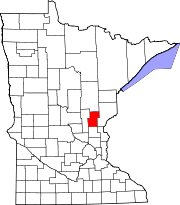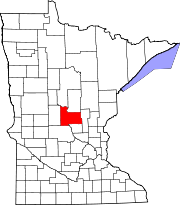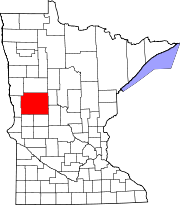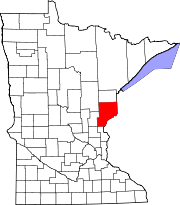- Mille Lacs Indian Reservation
-
Mille Lacs Indian Reservation is the land-base for the Mille Lacs Band of Ojibwe in Central Minnesota, about 100 miles (160 km) north of Minneapolis-St. Paul. The reservation has portions in Mille Lacs, Pine, Aitkin and Crow Wing counties, consisting of nine Band Statutes communities, as well as other land holdings in Kanabec, Morrison, and Otter Tail Counties.
Contents
Reservations
Mille Lacs Lake Indian Reservation
The main reservation of the Mille Lacs Indian Reservation is the Mille Lacs Lake Indian Reservation (Misi-zaaga'iganiing in the Ojibwe language), at 46°05′48″N 93°30′14″W / 46.09667°N 93.50389°W at the southern end of Mille Lacs Lake and composes about 60,975 acres (246.76 km2) of land (commonly rounded in citations as "61,000 acres"), consisting of Township 42 North, Ranges 25, 26 and 27 West, and Township 43 North, Range 27 West. Before the raising of the lake level, United States v. Mille Lac Band of Chippewa Indians (229 U.S. 498 (1913)) cites the reservation as being 61,015 acres (246.92 km2) of land. It was initially established in 1855 under the Treaty of Washington (10 Stat. 1165) for the Mille Lacs Indians. Under various Federal and State Executive Orders, the non-Native American have a few times thereafter altered the definition of the location of this Indian Reservation. The US Census Bureau designates this reservation as part of "2270: Mille Lacs Indian Reservation and Off-Reservation Trust Land".
This reservation contains the communities of Neyaashiing (Vineland) and Chi-minising (Isle). Neyaashiing houses the Mille Lacs Band of Ojibwe Government Center, Nay-Ah-Shing Lower and Upper Schools and the Ne-Ia-Shing Clinic. It hosts Minnesota Historical Society's Mille Lacs Indian Museum. Grand Casino Mille Lacs is also located in Neyaashiing. Within the Mille Lacs Lake Indian Reservation but not in one of the Mille Lacs Band communities are the central offices for Woodland National Bank and Circle of Health supplementary Health Insurance, both located in Onamia, Minnesota. Chi-minising houses the Chiminising Community Center and District IIa Government Services Center.
Sandy Lake Indian Reservation
Smaller of the Mille Lacs Indian Reservation is the Sandy Lake Indian Reservation (Gaa-mitaawangaagamaag in the Ojibwe language), located at 46°48′09″N 93°14′59″W / 46.8025°N 93.24972°W, surrounding Big Sandy Lake and composes about 20,192 acres (81.71 km2) of land, with the Gaa-mitaawangaagamaag Community of the Sandy Lake Band of Mississippi Chippewa adjacent to and within the northern portion of the Reservation and the Manoominikaan-zaaga'iganiing Community of the Rice Lake Band of Mississippi Chippewa located adjacent to the Reservation on the southern portion of the Reservation. Like Misi-zaaga'iganiing, it too was initially established in 1855 under the Treaty of Washington for the Sandy Lake Band of Mississippi Chippewa. Under various Federal and State Executive Orders, the non-Native American no longer recognize the existence of this Indian Reservation. Consequently, nearly all the land within this Reservation is non-Native American owned. The United States Army Corps of Engineers operate a small flood-control dam within this Indian Reservation. The US Census Bureau designates this reservation as "2385: Sandy Lake Indian Reservation".
Other reservation holdings
Aggregated as part of the US Census Bureau designated "2270: Mille Lacs Indian Reservation and Off-Reservation Trust Land", Mille Lacs Indian Reservation have scatted trust parcels less than 80 acres (32 ha) each in Pine, Kanabec, southern Aitkin, Crow Wing and Morrison Counties, Minnesota. In addition, Mille Lacs Indian Reservation maintains the land upkeep on the Minnesota Chippewa Tribe ricing parcel at Star Lake. Furthermore, each Minnesota Chippewa Tribe member reservation, including the Mille Lacs Indian Reservation, hold equal one-sixth (1/6) interest on all Minnesota Chippewa Tribe member reservations, though asserting jurisdiction only on their own reservation.
Districts
Due to the large territorial spread of the Mille Lacs Band of Ojibwe, the Mille Lacs Indian Reservation is divided into three Band Statute districts and one special services district.
District I
The Neyaashiing District (District I) serves the Band members living in the western two-thirds of the Misi-zaaga'iganiing and 30-mile (48 km) service area from that portion of the Reservation. In addition, any requested services outside of the pre-defined service districts are coordinated though this district.
District II
Gaa-mitaawangaagamaag District (District II) serves the Band members living in the eastern one-third of the Misi-zaaga'iganiing Reservation, all of Gaa-mitaawangaagamaag Reservation, the Manoominikaan-zaaga'iganiing Community and the Minisinaakwaang Community and 30-mile (48 km) service area from those locations.
This district is further sub-divided into two sub-districts: Districts IIa and IIb. District IIa is associated with the Chi-minising Community. District IIb comprises the rest of District II. The Minisinaakwaang Community is located approximately 6 miles (10 km) south of McGregor, MN. Minisinaakwaang Community houses the Mille Lacs Indian Reservation District II Community and Government Services Center, serving primarily District IIb.
District III
Aazhoomog District (District III) of the Mille Lacs Indian Reservation is located primarily in Pine County, comprises the Ne-zhingwaakokaag (Pine City-Rock Creek-Pokegama Lake) community of the Snake and Knife Rivers Band of the St. Croix Chippewa Indians of Minnesota, Gaa-zhiigwanaabikokaag (Hinckley) and Asinikaaning (Sandstone) communities of the Kettle River Band of St. Croix Chippewa Indians of Minnesota, and the Aazhoomog (Lake Lena) Village of the St. Croix Chippewa Indians of Minnesota, and 30-mile (48 km) service area from those locations. Though historically forming the western half of the St. Croix Chippewa Indians, the contemporary St. Croix Chippewa Indians of Wisconsin located east of the St. Croix River is considered a Federally Recognized Tribe, not associated with the Mille Lacs Band of Ojibwe, located west of the St. Croix River.
Aazhoomog Village houses the Mille Lacs Indian Reservation District III Community and Government Service Center and the Aazhoomog Clinic of the Ne-Ia-Shing Health Clinic system. Operating out of Gaa-zhiigwanaabikokaag is Grand Casino Hinckley and their various enterprises, including a golf-course, RV park and a concert hall.
Urban district
The Urban District of the Mille Lacs Indian Reservation is a special services district serving the large number of Mille Lacs Band of Ojibwe living in the Twin Cities. Originally in the Band Statutes, the Urban district was established and defined as being Anoka, Hennepin and Ramsey Counties, providing TANF services to Band-members in those three counties. While TANF services are still at the core of the Urban District, the Urban District has grown in providing other tribal supportive services, before available only on the Mille Lacs Indian Reservation proper. With a cooperative agreement with the city of Minneapolis, Minnesota, the Urban District provides affordable rental housing units to eligible low-income Band members.
Communities
Though only nine communities are cited in the Band Statutes, the Mille Lacs Indian Reservation has ten formal communities and additional six informal communities.
Ten formal communities:
- Vineland, Minnesota (Neyaashiing)
- Isle, Minnesota (Chi-minising)
- East Lake, Minnesota (Minisinaakwaang)
- Lake Minnewawa, Minnesota (Manoominikaan-zaaga'iganiing)
- Sandy Lake, Minnesota (Gaa-mitaawangaagamaag )
- Sandstone, Minnesota (Asinikaaning')
- Lake Lena, Minnesota (Aazhoomog)
- Hinckley, Minnesota (Gaa-zhiigwanaabikokaag)
- Pine City, Minnesota (Ne-zhingwaakokaag)
- The Twin Cities (Gichi-oodenaang)
Six informal communities:
- Brainerd, Minnesota (Oshki-oodenaang)
- Onamia, Minnesota (Gibaakwa'igaansing)
- Cove, Minnesota (Wiikwegamaang)
- Wahkon, Minnesota (Zaagawaamikaag-wiidwedong)
- Moose Lake, Minnesota (Mooz-eskani-zaaga'iganiing)
- Duluth, Minnesota (Onigamiinsing)
See also
- Minnesota Indian Affairs Council
- Aaniin Ekidong: Ojibwe Vocabulary Project. St. Paul: Minnesota Humanities Center, 2009.
- Treuer, Anton. Ojibwe in Minnesota. St. Paul: Minnesota Historical Society Press, 2010.
- Treuer, Anton. Living Our Language: Ojibwe Tales & Oral Histories. St. Paul: Minnesota Historical Society Press, 2001.
External links
Municipalities and communities of Aitkin County, Minnesota County seat: Aitkin Cities Townships Aitkin | Ball Bluff | Balsam | Beaver | Clark | Cornish | Farm Island | Fleming | Glen | Haugen | Hazelton | Hill Lake | Idun | Jevne | Kimberly | Lakeside | Lee | Libby | Logan | Macville | Malmo | McGregor | Millward | Morrison | Nordland | Pliny | Rice River | Salo | Seavey | Shamrock | Spalding | Spencer | Turner | Verdon | Wagner | Waukenabo | Wealthwood | White Pine | Williams | Workman
Unorganized
territoriesUnincorporated
communitiesGiese | Glen | Jacobson | Malmo | Sandy Lake | Swatara | Waukenabo
Indian
reservationsMille Lacs‡
Footnotes ‡This populated place also has portions in an adjacent county or counties
Municipalities and communities of Crow Wing County, Minnesota County seat: Brainerd Cities Baxter | Brainerd | Breezy Point | Crosby | Crosslake | Cuyuna | Deerwood | Emily | Fifty Lakes | Fort Ripley | Garrison | Ironton | Jenkins | Manhattan Beach | Nisswa | Pequot Lakes | Riverton | Trommald
Townships Bay Lake | Center | Crow Wing | Daggett Brook | Deerwood | Fairfield | Fort Ripley | Gail Lake | Garrison | Ideal | Irondale | Jenkins | Lake Edwards | Little Pine | Long Lake | Maple Grove | Mission | Nokay Lake | Oak Lawn | Pelican | Perry Lake | Platte Lake | Rabbit Lake | Roosevelt | Ross Lake | Sibley | St. Mathias | Timothy | Wolford
Unorganized
territoriesUnincorporated
communityLake Hubert
Indian
reservationMille Lacs
Ghost town Municipalities and communities of Kanabec County, Minnesota County seat: Mora Cities Townships Ann Lake | Arthur | Brunswick | Comfort | Ford | Grass Lake | Hay Brook | Hillman | Kanabec | Knife Lake | Kroschel | Peace | Pomroy | South Fork | Whited
Unincorporated
communitiesBrunswick | Coin | Lewis Lake | Warman
Indian
reservationMille Lacs‡
Footnotes ‡This populated place also has portions in an adjacent county or counties
Municipalities and communities of Mille Lacs County, Minnesota County seat: Milaca Cities Townships CDP Indian
reservationMille Lacs
Footnotes ‡This populated place also has portions in an adjacent county or counties
Municipalities and communities of Morrison County, Minnesota County seat: Little Falls Cities Townships Agram | Belle Prairie | Bellevue | Buckman | Buh | Culdrum | Cushing | Darling | Elmdale | Granite | Green Prairie | Hillman | Lakin | Leigh | Little Falls | Morrill | Motley | Mount Morris | Parker | Pierz | Pike Creek | Platte | Pulaski | Rail Prairie | Richardson | Ripley | Rosing | Scandia Valley | Swan River | Swanville | Two Rivers
Unincorporated
communityIndian
reservationMille Lacs
Footnotes ‡This populated place also has portions in an adjacent county or counties
Municipalities and communities of Pine County, Minnesota County seat: Pine City Cities Askov | Brook Park | Bruno | Denham | Finlayson | Henriette | Hinckley | Kerrick | Pine City | Rock Creek | Rutledge | Sandstone | Sturgeon Lake | Willow River
Townships Arlone | Arna | Barry | Birch Creek | Bremen | Brook Park | Bruno | Chengwatana | Clover | Crosby | Danforth | Dell Grove | Finlayson | Fleming | Hinckley | Kerrick | Kettle River | Mission Creek | Munch | New Dosey | Nickerson | Norman | Ogema | Park | Partridge | Pine City | Pine Lake | Pokegama | Royalton | Sandstone | Sturgeon Lake | Wilma | Windemere
Unincorporated
communitiesBeroun | Chengwatana | Cloverdale | Cloverton | Duquette | Friesland | Groningen | Lake Lena | Nickerson | Pokegama | Wareham | West Rock
Indian
reservationMille Lacs
Categories:- American Indian reservations in Minnesota
- Anishinaabe reservations and tribal-areas in the United States
- Ojibwe
- Native American tribes in Minnesota
- Populated places in Aitkin County, Minnesota
- Populated places in Mille Lacs County, Minnesota
- Populated places in Pine County, Minnesota
- Populated places in Kanabec County, Minnesota
- Populated places in Crow Wing County, Minnesota
- Populated places in Morrison County, Minnesota
- Populated places in Otter Tail County, Minnesota
Wikimedia Foundation. 2010.







